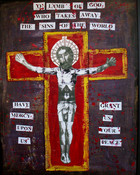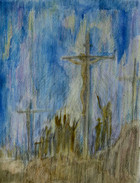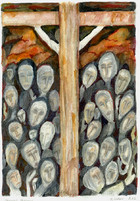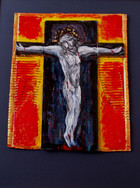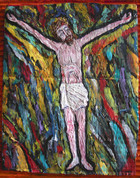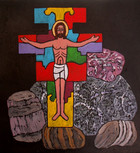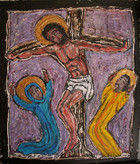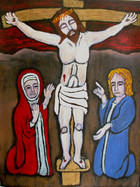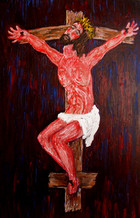The Passion of Christ
It would be hard to conceive of Christian art without scenes of the Crucifixion. Yet, images of Jesus hanging on the cross do not appear until the beginning of the 5th century. No doubt, early Christians reacted to visual reminders of this barbaric form of execution in the same way we do to photos of the electric chair. With the passage of time, the complex theological meaning of the God of the Universe humbly nailed on a crossbar of wood out of love for fallen humanity was simply too powerful to ignore in art. By the Middle Ages, patrons even paid to have their portraits included among the mourners, gathered at the foot of the cross in silent contemplation of the mystery of God’s plan of redemption, (as in Beneath the Cross).
For me, the Passion of Christ is the central image of sacred art, deeply disturbing, strangely consoling. I return to the Crucifixion time and again in my work, drawing inspiration from sources as diverse as the santero artists of New Mexico and Georges Rouault.
Agnus Dei presents a composite image of the suffering Christ drawn from the works of Michelangelo, Giovanni Bellini, Graham Sutherland and other noted interpreters of the Passion. Crucifixion After Rembrandt was inspired by the etchings of Rembrandt, which present the events in grand panorama, as if glimpsed by God. A drawing by St. John of the Cross, showing the suffering Christ, viewed at an angle from above, suggested Spanish Passion, where you look down on the seething crowd, as if hanging on the cross, yourself. Two expressionist paintings, Man of Sorrows and the central Crucifixion panel from The Salvation Story triptych show the suffering Christ pulled upward, almost weightlessly, through space, fulfilling his promise in John 12:32, KJV: “And I, if I be lifted up from the earth, will draw all men unto me.”
